About H-IIA Launch Vehicle
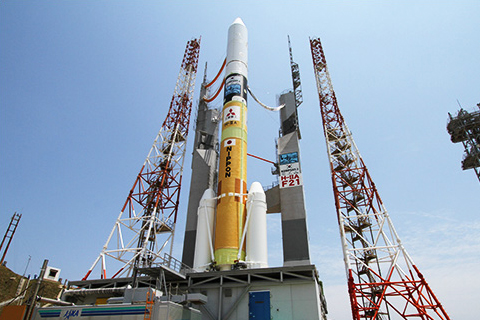 |
The H-IIA Launch Vehicle has been in operation since 2001 as a highly reliable large-sized mainstay rocket, and is continuously used in missions to launch satellites and space probes. The launch service operations were transferred in 2007 to Mitsubishi Heavy Industries, Ltd., with JAXA in charge of launch safety management (such as ensuring ground and flight safety). |
|---|
Project Topics
indexSuccessful Launch, H-IIA Launch Vehicle No. 40 Encapsulating "IBUKI-2"(GOSAT-2) and KhalifaSat
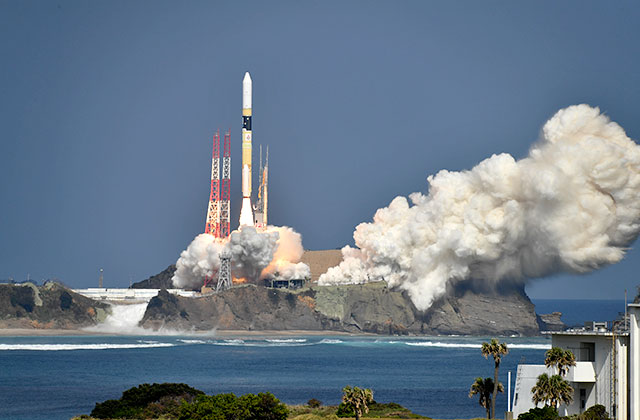
|
The H-IIA Launch Vehicle No. 40 with the Greenhouse gases Observing SATellite-2 "IBUKI-2"(GOSAT-2) and KhalifaSat, a remote sensing Earth observation satellite onboard lifted off at 13:08:00 p.m. on October 29, 2018 (Japan Standard Time) from the Tanegashima Space Center. The launch and flight of H-IIA F40 proceeded as planned. So did the separation of GOSAT-2 and KhalifaSat, which was confirmed respectively at approximately 16 minutes and 09 seconds and 24 minutes and 15 seconds after lifto... |
|---|
Press Release
index-
- Jun. 27, 2025 (14:00) [release]
- Launch Time and Launch window of the Global Observing SATellite for Greenhouse gases and Water cycle (GOSAT-GW) (Japanese Only)
-
- Jun. 24, 2025 (14:00) [release]
- Launch Schedule of the Global Observing SATellite for Greenhouse gases and Water cycle (GOSAT-GW)[Rescheduled] (Japanese Only)
Characteristics of H-IIA Launch Vehicle
Major Characteristics
Major Specifications of the H-IIA launch vehicle
| Length (m) | 53 |
|---|---|
| Liftoff mass (t) | 289 (without payload mass) |
| Guidance Method | Inertial Guidance Method |
| Item | |||||
|---|---|---|---|---|---|
| First Stage | SRB-A | SSB | Second Stage | Payload | |
| Length (m) | 37.2 | 15.1 | 14.9 | 9.2 | 12 |
| Diameter (m) | 4 | 2.5 | 1 | 4 | 4.07 |
| Mass (t) | 114 | 151 (2 units) | 31 (2 units) | 20 | 1.4 |
| Propellant mass | 101.1 | 130 (2 units) | 52.4 (4 units) | 16.9 | - |
| Thrust (KN) | 1,098 | 5,040 (2 units) | 1,490 (2 units) | 137 | - |
| Burning time (s) | 390 | 100 | 60 | 530 | - |
| Propellant | Lox/LH2 | Polybutadiene composite solid propellant | Polybutadiene composite solid propellant | Lox/LH2 | - |
| Propellant Loading Method | Turbo pomp | - | - | Turbo pomp | - |
| Specific Impulse (s) | 440 | 283 | 282 | 448 | - |
| Attitude control method | Gimbal engine system Auxiliary engine |
Gimballed nozzle system | Gimballed nozzle system | Gimbal engine system Gas jet system |
- |
| Avionics | Control Systems, Telemetry Transmitter |
- | - | Guidance Navigation, and Control Systems, Rader Transponder, Telemetly Transmitter, Command Destruct Receiver |
- |
Launch Capability (H-IIA Standard)
| Orbit | Altitude | Payloads |
|---|---|---|
| Geosynchronous Transfer Orbit (GTO) |
about 36,000km | about 4t |
| Low Earth Orbit (Inclination:30 degrees) |
about 300km | about 10t |
| Sun Synchronous Orbit (Summer/Other seasons) |
about 800km | about 4t / about 3.8t |
| Escape from the Earth Gravitation | Planetary Mission | about 2.5t |
H-IIA Lineup
H-IIA Launch Vehicle can be in various configurations by installing solid rocket boosters (SRB-As) additionally. H-IIA can answer various launch needs of payload size and weight by its family members.
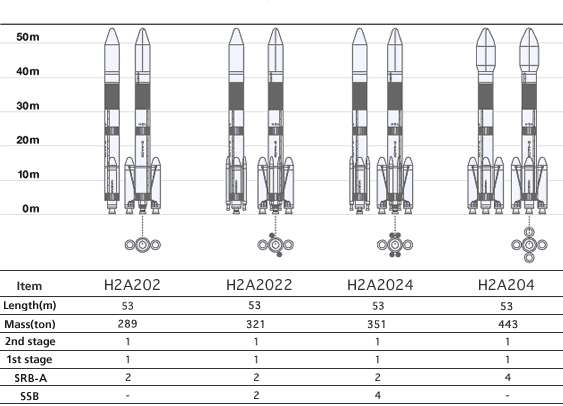
* Currently, only H2A202 and H2A204 types are in operation.
Upgrading JAXA's flagship launch vehicle
JAXA is proud of the launch success rate of the H-IIA Launch Vehicle, which is among the highest levels in the world. However, as it has been 14 years since its maiden launch, some issues have been raised such as the aging launch facility and the need for a larger payload launch capacity. JAXA is conducting the H-IIA upgrade project to tackle those issues. We will achieve more efficient launch vehicle operations by improving H-IIA launch capability and its global competitiveness, and simplifying the ground facility.
H-IIA Upgrade Project
Improved function and performance
(1) Enhanced launch capacity of a geostationary satellite
By
increasing the duration of flight time and the number of engine ignitions, more flexible flight
patterns become possible, and the launch capability of a geostationary satellite is also
increased.
- H-IIA UPGRADE -
Moving to a new stage
Enhanced launch performance to cope with geostationary satellite launch ? Adopting it to the H-IIA Launch Vehicle No. 29
(2) Easing the onboard environmental restriction for payloads
The onboard environment has been improved for payloads to among the highest levels in the world
by adopting a mechanism that is not based on pyrotechnics.
Reducing maintenance/renovation costs of facility
(3) Simplified ground facility
Ground tracking radars are no
longer necessary as the onboard flight safety navigation sensor was developed.
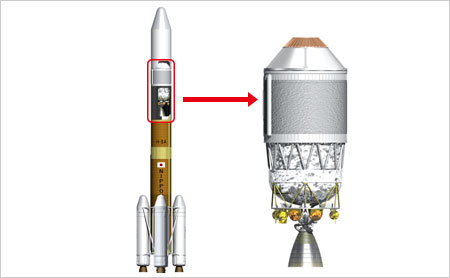
Launch Records
| Flight No. | Model | Launch Date | Payload |
|---|---|---|---|
| F42 | H2A202 | 7/20/2020 | The Emirates Mars Mission(EMM), "HOPE" probe |
| F41 | H2A202 | 2/9/2020 | IGS (Information Gathering Satellites) |
| F40 | H2A202 | 10/29/2018 | Greenhouse gases Observing SATellite-2 "IBUKI-2" (GOSAT-2) |
| F39 | H2A202 | 6/12/2018 | IGS (Information Gathering Satellites) |
| F38 | H2A202 | 2/27/2018 | IGS (Information Gathering Satellites) |
| F37 | H2A202 | 12/23/2017 | Global Change Observation
Mission - Climate "SHIKISAI" (GCOM-C) Super Low Altitude Test Satellite "TSUBAME" (SLATS) |
| F36 | H2A202 | 10/10/2017 | Quasi-Zenith Satellite-4 "MICHIBIKI No. 4" |
| F35 | H2A204 | 8/19/2017 | Quasi-Zenith Satellite-3 "MICHIBIKI No. 3" |
| F34 | H2A202 | 6/1/2017 | Quasi-Zenith Satellite-2 "MICHIBIKI No. 2" |
| F33 | H2A202 | 3/17/2017 | IGS (Information Gathering Satellites) |
| F32 | H2A204 | 1/24/2017 | X-band defense communication satellite-2 |
| F31 | H2A202 | 11/2/2016 | Geostationary Meteorological Satellite "Himawari-9" |
| F30 | H2A202 | 2/17/2016 | X-ray Astronomy Satellite "Hitomi" (ASTRO-H) |
| H-IIA UPGRADE F29 |
H2A204 | 11/24/2015 | Telstar 12 VANTAGE |
| F28 | H2A202 | 3/26/2015 | IGS (Information Gathering Satellites) |
| F27 | H2A202 | 2/1/2015 | IGS (Information Gathering Satellites) |
| F26 | H2A202 | 12/3/2014 | Asteroid Explorer "Hayabusa2" |
| F25 | H2A202 | 10/7/2014 | Geostationary Meteorological Satellite "Himawari-8" |
| F24 | H2A202 | 5/24/2014 | Advanced Land Observing Satellite-2 "DAICHI-2" (ALOS-2) |
| F23 | H2A202 | 2/28/2014 | Global Precipitation Measurement/Dual-frequency Precipitation Radar (GPM/DPR) |
| F22 | H2A202 | 1/27/2013 | IGS (Information Gathering Satellites) |
| F21 | H2A202 | 5/18/2012 | Global Change Observation
Mission 1st - Water "SHIZUKU" (GCOM-W1) Small Demonstration Satellite-4 (SDS-4) |
| F20 | H2A202 | 12/12/2011 | IGS (Information Gathering Satellites) |
| F19 | H2A202 | 9/23/2011 | IGS (Information Gathering Satellites) |
| F18 | H2A202 | 9/11/2010 | Quasi-Zenith Satellite-1 "MICHIBIKI" |
| F17 | H2A202 | 5/21/2010 | Venus Climate Orbiter
"AKATSUKI" (PLANET-C) Interplanetary Kite-craft Accelerated by Radiation Of the Sun "IKAROS" |
| F16 | H2A202 | 11/28/2009 | IGS (Information Gathering Satellites) |
| F15 | H2A202 | 1/23/2009 | Greenhouse gases Observing
SATellite "IBUKI" (GOSAT) Small Demonstration Satellite-1 (SDS-1) |
| F14 | H2A2024 | 2/23/2008 | Wideband InterNetworking engineering test and Demonstration Satellite "KIZUNA" (WINDS) |
| F13 | H2A2022 | 9/14/2007 | SELenological and ENgineering Explorer "KAGUYA" (SELENE) |
| F12 | H2A2024 | 2/24/2007 | IGS (Information Gathering Satellites) |
| F11 | H2A204 | 12/18/2006 | Engineering Test Satellite VIII "KIKU No.8" (ETS-VIII) |
| F10 | H2A202 | 9/11/2006 | IGS (Information Gathering Satellites) |
| F9 | H2A2024 | 2/18/2006 | Multi-functional Transport Satellite-2 "Himawari-7" (MTSAT-2) |
| F8 | H2A2022 | 1/24/2006 | Advanced Land Observing Satellite "Daichi" (ALOS) |
| F7 | H2A2022 | 2/26/2005 | Multi-Functional Transport Satellite-1 Replacement "Himawari-6" (MTSAT-1R) |
| F6 | H2A2024 | 11/29/2003 | IGS (Information Gathering Satellites) * H-IIA F6 was consequently destroyed by a destruction command from the ground as the vehicle did not gain enough height and speed due to the failure. |
| F5 | H2A2024 | 3/28/2003 | IGS (Information Gathering Satellites) |
| F4 | H2A202 | 12/14/2002 | Advanced Earth Observation
Satellite-II "Midori II" (ADEOS-II) Engineering Test Satellite "Micro-LabSat" Whale Ecology Observation Satellite (WEOS) Federation Satellite (FedSat) |
| F3 | H2A2024 | 9/10/2002 | Data Relay Test Satellite
"KODAMA" (DRTS) Unmanned Space Experiment Recovery System (USERS) |
| TF2 | H2A2024 | 2/4/2002 | Mission Demonstration test
Satellite-1 "TSUBASA" (MDS-1) H-IIA Vehicle Evaluation Payload #3 (VEP-3) DASH (Demonstrator of Atmospheric Reentry System with Hyper Velocity) |
| TF1 | H2A202 | 8/29/2001 | Laser Ranging Equipment (LRE) H-IIA Vehicle Evaluation Payload #2 (VEP-2) |
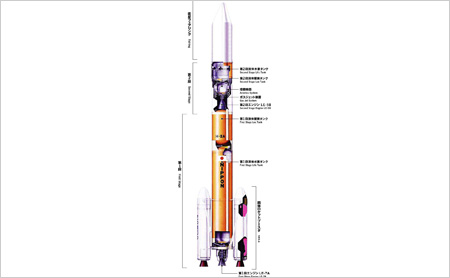 Large Image
Large Image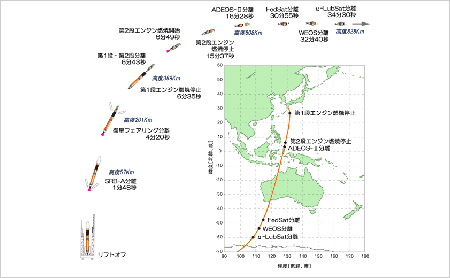 Large image
Large image
